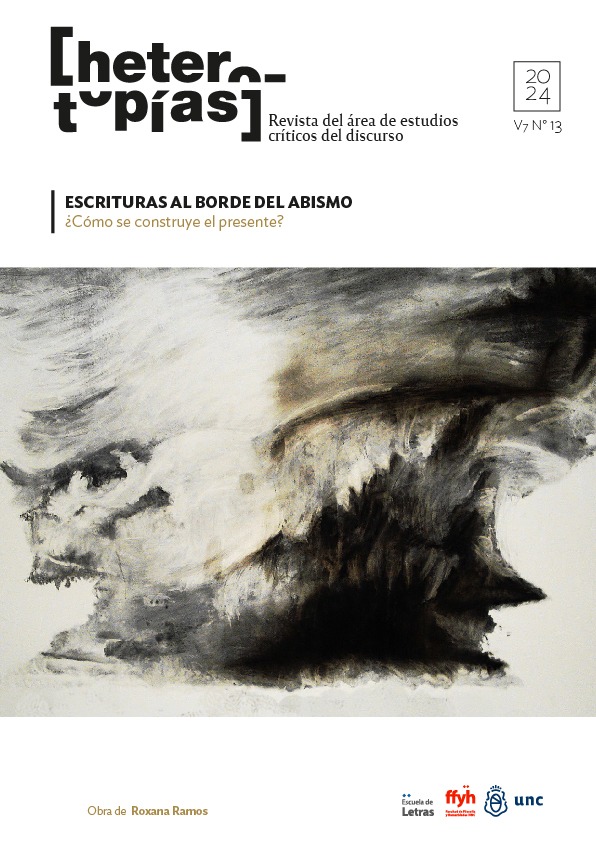The impacts
Main Article Content
Abstract
We propose to analyse certain artistic and community practices in the context of fumigated towns in Argentina, with the aim of distinguishing their differences with respect to other cultural practices. The methodology employed will therefore be transdisciplinary, as it will not only examine specific cultural practices, but will also relate them to scientific, political and social discourses on the problems they involve. In this sense, we consider that the approach to these cultural practices contributes to making visible a mode of presente art that is differentiated from traditional and modern conceptions of the arts, as well as problematising the merely aestheticist valuation.
Downloads
Article Details

This work is licensed under a Creative Commons Attribution-NonCommercial-ShareAlike 4.0 International License.
Those authors who have publications with this journal, accept the following terms: Those authors who have publications with this journal, accept the following terms:
a. The authors will keep their copyright and guarantee to the journal the right of first publication of their work, which will be simultaneously subject to the Creative Commons Attribution - Non-Commercial - Share Alike (by-nc-sa) Attribution License; no commercial use of the original work or any derivative works is allowed, the distribution of which must be done with a license equal to the one that regulates the original work.
b. Authors may adopt other non-exclusive license agreements for the distribution of the published version of the work (e.g., deposit it in an institutional telematic archive or publish it in a monographic volume) provided that the initial publication in this journal is indicated.
c. Authors are allowed and recommended to disseminate their work through the Internet (e.g. in institutional telematic archives or on their website) before and during the submission process, which may lead to interesting exchanges and increase the number of citations of the published work. (See The effect of open access).
References
Agost, Lisandro , Pujol, Céline y Bertone, Carola (2015). “Análisis de la incidencia del cáncer por departamento en la provincia de Córdoba-Argentina (2004-2008): tasas de incidencia y detección de conglomerados espaciales”. Revista Cuestiones de Población y Sociedad, Vol. 5, N°5, Año IV, pp. 9-23.
Alonso, Martín; Fita, Rosalba; Nicolás, Graciela; Carballo Quinteros, Beatriz; González, Diego; Álvarez, Marcela; Ortega, Daniel; Senmartin, Cecilia; Audisio, María Lucrecia (2013). Informe sobre cáncer en la provincia de Córdoba. 2004 – 2009. Publicación del Registro Provincial de Tumores de Córdoba. Gobierno de la Provincia de Córdoba: chrome-extension://efaidnbmnnnibpcajpcglclefindmkaj/https://reduas.com.ar/wp-content/uploads/downloads/2016/09/Libro-Cancer-Provincial.pdf
Avila-Vazquez, Medardo y Difilippo, Flavia (2016). “Agricultura tóxica y salud en pueblos fumigados de Argentina”. Crítica y Resistencias. Revista de conflictos sociales latinoamericanos. N° 2, pp. 23-45 Azamar Alonso, Aleida; Silva Amador, José Carlos; Zuberman, Federico (Coords.)
(2021). Economía ecológica latinoamericana. Buenos Aires: Clacso-Siglo XXI.
Bidaseca, Karina (2022). Descolonizar el tercer espacio entre Oriente y Occidente. Estéticas feministas situadas en el Sur. Buenos Aires: CES.
Braga, Andrea (2022). Legítima defensa.
Carrasco, Andrés (2011). “El glifosato: ¿es parte de un modelo eugenésico?” en Salud colectiva vol.7 no.2 Lanús mayo/ago.
Celis, Rubén(2009). “Carta al lector”. El Informante. Marzo, Leones.
Comisión nacional de investigación sobre agroquímicos (2009). Decreto 21/2009. “Evaluación de la información científica vinculada al glifosato en su incidencia sobre la salud humana y el ambiente”. Buenos Aires: CONICET.
De la Orden, Ulises (2013). Desierto verde.
En Grupo (2012). Mural sobre agrotóxicos en Marcos Juárez.
Latour, Bruno (2001). Nunca fuimos modernos. Buenos Aires: FCE.
Muñoz S., Aballay L, Butinof M, Lantieri M., Pou S., Meyer Paz R. y Díaz Mp. (2007). “Epidemiología ambiental del cáncer en Córdoba: Patrón poblacional de incidencia y bases para la identificación de factores de riesgo” en IX Jornadas Argentinas de Estudios de Población. Asociación de Estudios de Población de la Argentina, Huerta Grande, Córdoba. Disponible en: chrome-extension://efaidnbmnnnibpcajpcglclefindmkaj/https://www.aacademica.org/ 000-028/26.pdf
Piovano, Pablo. “Las sombras del éxito”. En: pablopiovano.com
Piovano, Pablo (2016). El costo humano de los agrotóxicos. Muestra. Buenos Aires: Palais Glace.
Registro Provincial de Tumores de Córdoba (2017). Cáncer: Incidencia y Mortalidad en Córdoba. 2004-2013. Provincia de Córdoba y Departamento Capital. Gobierno de la Provincia de Córdoba. Disponible en: Chrome-extension://efaidnbmnnnibpcajpcglclefindmkaj/https://ministeriodesalud.cba. gov.ar/wp-content/uploads/2019/11/PUBLICACION-REGISTRO-DE-TUMORES-2004-2013.pdf
Sabbatella, I (2010). “Crisis ecológica y subsunción real de la naturaleza al capital” en Revista de Ciencias Sociales. Núm. 36, p.77.
Sbarato, Darío (2007). Estudios y propuestas ambientales. Leones, Córdoba, Argentina. Río Cuarto: UTN.
